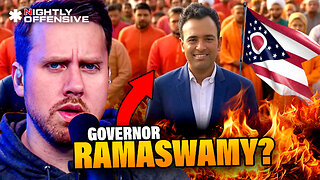Premium Only Content

French Resistance & D-Day 1944 Archive Footage Paris Partisans SOE Charles Bovill
French Resistance Archive Footage Paris Partisans SOE Charles Bovill
View on YouTube
YouTube Views before Google 4th Reich removed this along with my entire channel: 76,970
Category: News & Politics
Special Operations Executive (Organization) | French Resistance (Literature Subject) | Interview | Liberation Of Paris (Event) | Interviews | Nazi | occupation | Footage | Archive
Published on Sep 7, 2013
Resistance Movements occurred in every occupied country by a variety of means, ranging from non-cooperation, disinformation and propaganda to hiding crashed pilots and even to outright warfare and the recapturing of towns. Resistance movements were the people of the inhabited place trying to stop the Nazi Government. Resistance movements are sometimes also referred to as " the underground".
Among the most notable resistance movements were the Yugoslav Partisans (largest in WW2), the Polish Home Army, the Soviet partisans, the French Forces of the interior, the Italian CLN, the Norwegian Resistance, the Greek resistance and the Dutch Resistance.
Jean Moulin, de Gaulle's representative in France, tasked with unifying the various French Factions into one French Resistance Movement. Moulin was betrayed in 1943 and was tortured to death by Klaus Barbie (Head of the Gestapo in Lyon), nicknamed the Butcher of Lyon. This served only to strengthen the resolve of the resisters and Moulin is hailed as " a famous son of France ".
www.en.wikipedia.org/wiki/Jean_Moulin
www.en.wikipedia.org/wiki/Klaus_Barbie
Many countries had resistance movements dedicated to fighting the Axis invaders and Germany itself also had an anti- Nazi movement. Although Britain didnt suffer the Nazi occupation in WW2, the British made preparations for a British Resistance Movement, called Auxilliary Units, in the event of a German Invasion. Various organisations were also formed to establish foreign resistance cells or support exisiting resistance movements, like the British SOE and the American OSS.
There were also resistance movements fighting against the Allies. In Italian East Africa, after the Italian forces were defeated during the East African Campaign, some Italians partcipated in a guerilla war against the British (1941-1943). The German Nazi Resistance movement ("Werwolf") never mounted to much. On the other hand, the " Forest Brothers" of Estonia, Latvia and Lithuania included many fighters who fought for the Nazis and operated against the Soviet Occupation .
Organisation
Organsiation was dangerous, so much resistance was done by individuals. The possibilities depended much on the terrain, where there were large tracts of uninhabited land, especially hills and forests, resistance could more easily get organsied undetected. This favoured in particular the Soviet Partisan in Russia. In the much more densely populated Netherlands, the Biesbosch wilderness could be used to go into hiding. In Northern Italy, both the Alps and Appennines offered shelter to partisan brigades though many groups operated directly inside the major cities.
There were many types of groups, ranging in activity from humanitarian aid to armed resistance, sometimes cooperating to a varying degree. Resistance usually arose spontaneously but was encouraged and helped mainly from London and Moscow.
Various forms of resistance were
1. Non- violent ie Sabotage where locals, forced to work for the Nazis would work slowly or badly - Strikes and demonstartion - Professional Resistance by churches, students, Doctors or other professionals.
2. Armed ie raids on distribution offices for food or doucuments, temporary liberation of areas such as in Yugoslavia, Paris and Northern Italy occasionally assisted by the Allies- uprisings as in Warsaw in 1943/1944- continuous battle and guerilla warfare, such as partisans in the USSR and Yugoslavia or the Maquis in France
3.Espionage, including sending reports of military importance (eg troop movements, weather etc
4.Illegal press to counter Nazi propaganda
5.Politaical resistance to prepare for the reorganisation after the war
6.Helping people go into hiding (eg to escape froced labour or deportation as took place in the Netherlands
7.Helping Allied military personnel caught behind the Lines
http://libertesoe.webs.com/theresistance.htm
THE RESISTANCE CONTINUES
Secret files reveal 9,000 Nazi war criminals fled to South America after WWII
As many as 5,000 Nazis went to Argentina
Between 1,500 and 2,000 ended up in Brazil
Around 500 to 1,000 settled in Chile
The rest started new lives in Paraguay and Uruguay
http://www.dailymail.co.uk/news/article-2117093/Secret-files-reveal-9-000-Nazi-war-criminals-fled-South-America-WWII.html
-
 2:39:16
2:39:16
TimcastIRL
11 hours agoDemocrat CAUGHT ON TAPE ADMITTING To Corruption, CHEATING ON WIFE Says Nick Sortor | Timcast IRL
188K72 -
 1:02:08
1:02:08
Man in America
16 hours agoTrump to BAN the COVID Vaxx?! mRNA in Your Organic Meat?! w/ Kim Bright
78.6K66 -
 57:42
57:42
Flyover Conservatives
1 day agoThe Great Gold Cover-Up: Is Fort Knox EMPTY?! - Clay Clark + Dr. Kirk Elliott | FOC Show
58.3K19 -
 1:24:40
1:24:40
Kim Iversen
13 hours agoJeffrey Sachs Just Exposed the Truth They Don’t Want You to Hear
73.9K101 -
 2:11:32
2:11:32
Glenn Greenwald
11 hours agoGlenn From Moscow: Russia Reacts to Trump; Michael Tracey Debates Ukraine War | SYSTEM UPDATE #413
168K94 -
 2:19:23
2:19:23
Slightly Offensive
11 hours ago $14.65 earnedGOV. RAMASWAMY? Vivek to import 1 BILLION INDIANS to OHIO | Nightly Offensive
88.7K51 -
 4:51:08
4:51:08
Wahzdee
15 hours agoSniper Elite Then Extraction Games—No Rage Challenge! 🎮🔥 - Tuesday Solos
105K3 -
 2:12:58
2:12:58
Robert Gouveia
14 hours agoSenator's Wife EXPOSED! Special Counsel ATTACKS; AP News BLOWN OUT
112K69 -
 55:07
55:07
LFA TV
1 day agoDefending the Indefensible | TRUMPET DAILY 2.25.25 7PM
62.4K21 -
 6:09:26
6:09:26
Barry Cunningham
21 hours agoTRUMP DAILY BRIEFING - WATCH WHITE HOUSE PRESS CONFERENCE LIVE! EXECUTIVE ORDERS AND MORE!
186K79